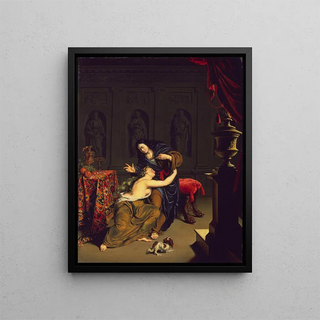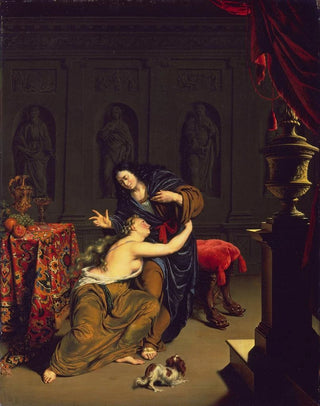Art print | Joseph and Potiphar's wife - Willem van Mieris


View from behind

Frame (optional)
The artwork "Joseph and Potiphar's Wife" by Willem van Mieris awakens the senses and immerses the viewer in a scene filled with tension and drama. This painting, inspired by the biblical story, depicts a pivotal moment where Joseph's virtue is tested by Potiphar's wife's advances. The composition, rich in emotion, invites exploration of themes such as temptation, morality, and the consequences of human choices. Through this art print, the artist manages to capture the very essence of humanity while offering a window into the customs of his time.
Style and uniqueness of the work
Willem van Mieris's technique is distinguished by its finesse and attention to detail. In "Joseph and Potiphar's Wife," the textures of the clothing, the luminosity of the faces, and the expressions of the characters are rendered with remarkable precision. The artist uses a palette of warm colors, creating an atmosphere that is both intimate and dramatic. The interplay of light and shadow accentuates the emotions of the protagonists, making the scene even more vivid. Joseph's posture, both stoic and vulnerable, contrasts with the boldness of Potiphar's wife, symbolizing the conflict between desire and restraint. This painting, with its balanced composition and expressiveness, stands out from contemporary works, revealing a baroque style that skillfully blends realism and idealization.
The artist and his influence
Willem van Mieris, active in the 17th century, is an emblematic representative of the Dutch school. His work is part of a tradition where visual storytelling and the expression of emotions are paramount. Influenced by masters such as Rembrandt and Vermeer, van Mieris developed a distinctive style characterized by sensitivity to detail and mastery of lighting. His ability to tell stories through painting had a lasting impact on his contemporaries and inspired many artists. By exploring classical and biblical themes, he contributed to the evolution of narrative painting, placing the human at the heart of his artistic concerns. His reputation endures, and

Matte finish

View from behind

Frame (optional)
The artwork "Joseph and Potiphar's Wife" by Willem van Mieris awakens the senses and immerses the viewer in a scene filled with tension and drama. This painting, inspired by the biblical story, depicts a pivotal moment where Joseph's virtue is tested by Potiphar's wife's advances. The composition, rich in emotion, invites exploration of themes such as temptation, morality, and the consequences of human choices. Through this art print, the artist manages to capture the very essence of humanity while offering a window into the customs of his time.
Style and uniqueness of the work
Willem van Mieris's technique is distinguished by its finesse and attention to detail. In "Joseph and Potiphar's Wife," the textures of the clothing, the luminosity of the faces, and the expressions of the characters are rendered with remarkable precision. The artist uses a palette of warm colors, creating an atmosphere that is both intimate and dramatic. The interplay of light and shadow accentuates the emotions of the protagonists, making the scene even more vivid. Joseph's posture, both stoic and vulnerable, contrasts with the boldness of Potiphar's wife, symbolizing the conflict between desire and restraint. This painting, with its balanced composition and expressiveness, stands out from contemporary works, revealing a baroque style that skillfully blends realism and idealization.
The artist and his influence
Willem van Mieris, active in the 17th century, is an emblematic representative of the Dutch school. His work is part of a tradition where visual storytelling and the expression of emotions are paramount. Influenced by masters such as Rembrandt and Vermeer, van Mieris developed a distinctive style characterized by sensitivity to detail and mastery of lighting. His ability to tell stories through painting had a lasting impact on his contemporaries and inspired many artists. By exploring classical and biblical themes, he contributed to the evolution of narrative painting, placing the human at the heart of his artistic concerns. His reputation endures, and






